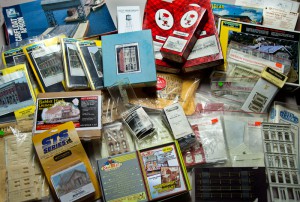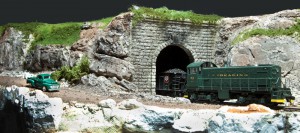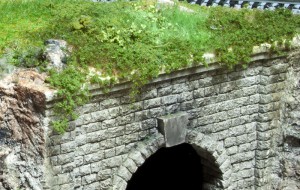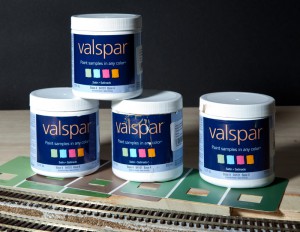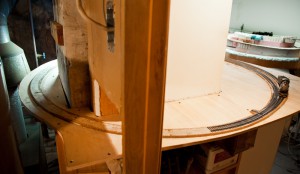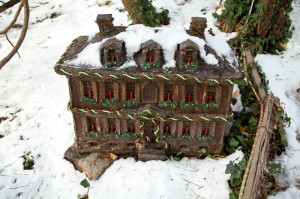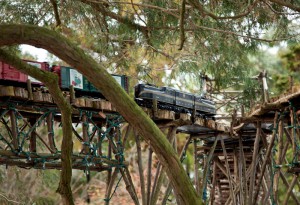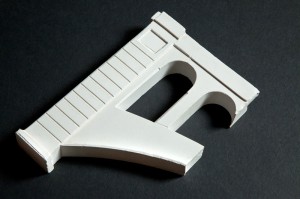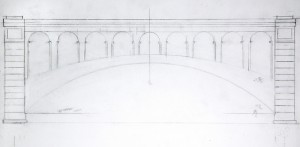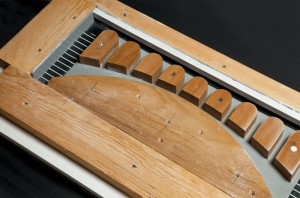I think it’s time I stopped looking at lots of structure kits and parts, and start making a place for the inhabitants of the railroad towns to live their lives. Building starts are looking up in this world.
Author Archives: Bob Emmott
1st Scenery Post
Working with my new Noch Gras Master as well as Heki micro flor, and some silflor products all purchased from Scenic Express, I started in on what is my favorite part of model making, the Scenery and what I would call the general mood of the place.
The rocks (Woodland Scenics molds)
were colored with washes of the thinned valspar paint that I talked about in the last post, as well as thinned India ink.
This particular scene will continue to be worked on, but I wanted to show how the 1st section appeared after the initial go round.
I especially like the texture lent by the Gras Master and the hanging vine look from the Heki Micro Flor.
Of course the rocks up front are still just raw Hydrocal.
Scenery Paint
A really good source for scenery paint is a service that both Lowes and Home Depot are offering. They sell samples of any of the hundreds of colors in their Valspar(Lowes) or Behr(Home Depot) lines at $3.00 ea. These samples are in handy screw top plastic containers of approx. 8 Oz.
That’s a whole lot more than typical railroad paint, or even the colors that are sold in the craft stores in 2oz containers.
I would not use these samples for painting anything that the much finer ground pigments of the true railroad colors would preserve detail, but for ground color, thinned for rock staining, etc and the fact that you can pick any one of the hundreds, or even thousands of chip colors displayed in the stores, and then they make the sample for you is just great.
Next post I’ll put up my first scenery using this paint and the Noch Gras Master
State of the layout Jan 2011
Back after the holidays,
My plan is to write articles going forward on 4 to 5 general categories, and to keep moving ahead on all of the them, working on different parts of the layout. Obviously you have to do things in a certain order for some of the processes but I do enjoy seeing a small part become more detailed, more finished, as though that area is emerging from the simpler surroundings.
The first view shows most of the layout area as it stands now at the end of January 2011.That is except for the run through the furnace and hot water heater area of the basement, in photo 2, going through the wall.
Morris Arboretum Christmas trains
If you are ever in Philadelphia, it is worth a visit to the Morris Arboretum in the Chestnut Hill section of the city.
It is a wonderful garden experience as well as a terrific garden railroad, that winds under shrubs, trees and has many bridges, including one that passes overhead. There must be 8 or 10 trains running at once as well as Hill climbing geared cars.
It is open during warm weather, from approx April to October and then Holiday themed trains running from Thanksgiving until Jan 2nd.
The buildings are constructed of natural materials (pine cones, bark, reeds, branches etc. and are of historical buildings from the Philadelphia area. For the Holidays the houses are decorated with lights, garlands, candles, wreaths,etc.
Track and the Holidays
Busy working on getting some new track in place before my grandsons Cooper and Fletcher arrive.
A combination of Central Valley and Micro Engineering track and switches, with help from the afore mentioned Ribbonrail track gauges.
I hope everyone has a great holiday season, and I’ll see you next year
Lin’s Junction
Finally went to Lin’s Junction Hobby Shop in Lansdale PA on Saturday to pick up some ribbonrail radius track gauges.
Been wanting to go there after seeing their ads as part of the DC / DCC Dealers Association. Will be going back to switch over to DCC, hopefully in the coming year.
They really seemed to have a good selection of quality items, including the track gauges I was searching for, lots of variety in brands of track available, and as expected, DCC systems, decoders , etc.
Of course there was the mysterious derailment of a train with full size corn cob cargo in their outside display in front of the store. Perhaps full size squirrel intervention!
Greenberg’s Phila Show
Always nice to see the Kids eyes at a train show like the Greenberg’s show I just attended at the Philadelphia Expo center at Oaks PA. Especially the Large G Scale layout they had set up with large lit Christmas trees in the center next to a mountain. Also always fun to see the Phila Ntrack modular layout, especially the modules by Alan Schappel.
The show is of course different than The Great Scale Model Train Show in Timonium MD, which is more serious in keeping with a scale presentation and having more manufacturers and custom model makers, but this is close to Christmas, and seeing the kids in their own fantasy world is a great time too.
A Test Casting
Shown here is a test casting, in Hydrocal, of a section of the concrete arch bridge. I wanted to test how the plaster would exit the mold. It was difficult, even in this small section, and even though I had built the mold with a 3 degree taper for the pieces forming the small enclosed arches. The outside pieces of the mold all are removable and that was fine, so I decided to make each of the individual small arch pieces separately removable, so one by one they can be eased out of the whole piece. Hopefully I will have a photo of a completed full casting sometime in the near future. I was pleased by the look of the piece and anxious to see a whole side intact!
Bridge Building
Designing my layout, I wanted to incorporate different types of bridges (I suppose that’s a thought of many model railroaders), but I wanted to design some of my own bridges in a freelanced but believable way. There are a number of concrete arch bridges in my area of NW Philadelphia including the Walnut Lane Bridge and the Henry Avenue Bridge, both Highway spans but seemingly constructed very similar to many railroad bridges of the same type. I also referred to the terrific book “Bridge and Trestle Handbook” by Paul Mallery to keep me building a basically sound engineered structure.
The Drawing shows my design for a concrete arch bridge to span a gorge that will be right in the front of my layout.
The photo shows the form I built to cast the bridge (actually half the bridge) as two castings back to back will form the bridge.
The form is made from Wood and sintra.

